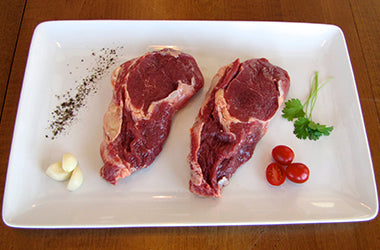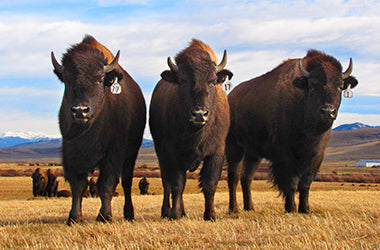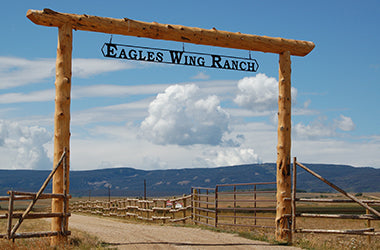What are the benefits of eating Grass-fed Bison?
Bison are ruminants, with a digestive system extremely effective at digesting grass - not grains, by-products or other stuff foreign to their natural diet. Most people assume that Bison are by definition exclusively grass-fed, which is not necessarily the case; many Bison operations include grain-based formulations in the animals' feed mixture during a period of time prior to harvest. However, we think Mother Nature did a pretty great job making the Bison naturally succulent, lean and healthy without all that stuff - a 100% grass fed-and-finished Bison tastes like a Bison should!
A Bison raised and finished exclusively on grass also has many times the levels of Omega 3, conjugated linoleic acid (CLA), and vitamins such as E and beta-carotene vs. a Bison that has been fed grain. Omega 3 and CLA are linked to the prevention of heart disease, arthritis, diabetes and cancer - so when you make a point to choose 100% grass-fed and finished Bison, you're getting exactly the healthy meat you've been looking for.
Our grass fed and finished Bison are naturally raised, without the use of drugs, hormones or antibiotics. They spend their lives in our vast pastures, eating the legendary North Park hay and drinking pure mountain water flowing directly from Routt National Forest. We do not finish our Bison on grain, and find that our Bison meat is more juicy and tender than any we’ve ever tried. See if you agree!
Shop Now
How is our Bison processed?
All meat is flash frozen, vacuum sealed in BPA free packaging, and stored at a constant temperature to ensure our tasty Bison reaches you with the very best flavor and texture.
Our desire to treat our Bison with care and respect extends all the way to the time of harvest. All Bison are slaughtered, processed & packaged by a family-owned, USDA-inspected Bison processing facility in Pierce, CO. We work exclusively with them because of the quality of their work, as well as their geographic location and their handling of our animals. They are the closest USDA-inspected Bison facility to Eagles Wing Ranch, which helps minimize the time of transport for the Bison. They have also designed their operation to ensure humane treatment and minimize stress prior to slaughter.
Shop Now
How do I know if the Bison I buy is grass-fed with no grain?
We at Eagle's Wing Natural Bison follow strict guidelines to ensure our bison only eat hay. If purchasing bison elsewhere be sure the label says "100% grass-fed". If it doesn't, chances are it isn't totally grass-fed.
Shop Now
Why don't I see all of your cuts on the website?
We harvest our bison each fall. The reason for this, is that is the best time to harvest them after they have eaten our rich grass hay all summer. We run out of some cuts as the year progresses since we only harvest once yearly. If you want to take advantage of our huge variety of cuts, be sure and check our website at the end of October when we are in stock with everything.
Shop Now
Where did the word "buffalo" come from?
In the seventeenth century, French explorers in North America referred to the new species they encountered as “les boeufs”, meaning oxen or beeves. The English, arriving later, changed the pronunciation to “la buff”. The name grew distorted as “buffle”, “buffler”, “buffillo”, and, eventually, “buffalo”. (from The American Buffalo in Transition, by J. Albert Rorabacher.)
Shop Now
What is the difference between bison and buffalo?
Scientifically, the term “buffalo” is incorrect for the North American species; its proper Latin name is bison. However, common usage has made the term “buffalo” an acceptable synonym for the American bison. (from The American Buffalo in Transition, by J. Albert Rorabacher.)
Shop Now
How much do bison weigh?
A mature bison bull will weigh approximately 2,000 pounds while a mature bison cow will weigh approximately 1,100 pounds.
Shop Now
How fast can a bison run?
Bison are very fast and can run at speeds up to 40 MPH. They are also very agile. At our ranch we have seen a bison jump a 7 foot fence standing still, with barely a hoof brushing the fence as he went over!
Shop Now
What is the weight of a bison calf?
They normally weigh between 40 to 50 pounds. They are usually up and walking or running with their mothers within a couple hours of being born.
Shop Now
What is the gestation period of a female bison?
The gestation period for the American bison is 9 1/2 months. Under normal conditions, cows have their calves from mid-April through June. Cows generally have one calf per year, but twins may occur very rarely.
Shop Now
How many calves will a bison have in her lifetime?
Female bison breed when they are two years old and have their first calves when they are three. Cows can live to be 20-25 years old having a calf each year under the right conditions.
Shop Now
Are bison gentle or aggressive?
Bison are not domestic animals and should be treated with caution and respect. Each animal has its own distinct personality, and are a very interesting animal.They are also very familial. That is, families tend to stay together. We have even seen them mourn their dead.
Shop Now
Do all bison have horns?
Is bison fur soft?
Bison have coarse guard hairs and a soft wool undercoat. Their hair keeps them warm in winter as the hairs are hollow and provide great insulation. They can survive very cold winters. They tend to do better in cooler areas than warm. Which may be one reason why you don't see very many bison in the southern areas of the country. Our bison survive very well on our ranch in the cool climate of North Park Colorado, high on the Continental Divide.
Shop Now
Do bison have front teeth?
What is the nutritional value of bison?
Bison meat contains 2.42 grams of fat, 143 calories, and 82 milligrams of cholesterol per 100 grams of cooked lean meat.
Comparatively, beef: 9.28 grams of fat, 211 calories, and 86 milligrams of cholesterol; pork: 9.66 grams of fat, 212 calories, 86 milligrams of cholesterol; chicken (skinless): 7.41 grams of fat, 190 calories, 89 milligrams of cholesterol.
Shop Now
How many bison are there in North America?
There are approximately 500,000-head.
Shop Now
Does buffalo milk or buffalo cheese (mozarella) come from bison?
No. Any product labeled as buffalo milk, or buffalo cheese is produced from the milk of water buffalo. Water buffalo are a separate species, and are not related to bison, even though American bison are commonly known as buffalo. Bison are not milked commercially for a couple of reasons. First, the teats on female bison are very small. Also, bison are undomesticated animals, and the females do not adapt well to the type of handling necessary in a milking operation.
Shop Now
What is the spiritual relationship between the bison and the American Indian Culture?
It varies from tribe to tribe. However, many of the tribes relied on bison not just for meat, but for shelter, clothing, and a source of utensils, tools, etc. The bison naturally became a spiritual focus for many American Indian tribes. Often, the creation legends of the tribes included the bison. (from Buffalo Nation, by Valerius Geist.)
Shop Now




